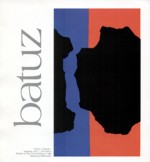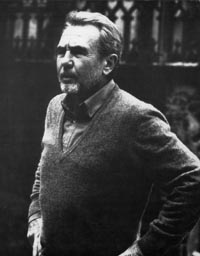
|
|||||
  
|
1965 | One-man shows in Buenos Aires and Mar del Plata. Birth of second son, Bandi. | |||
| 1966 | Shows at Circulo and Van Riel galleries in Buenos Aires. | ||||
| 1967 | Batuz accepted an invitation to exhibit in West Germany. Used the occasion to visit friends, some not seen for 30 years. Visited Oskar Kokoshka at his home in Villeneuve. First meeting with Dieter Ronte, lifelong friend and collaborator. Met Carlos Arean, Director of the Contemporary Museum of Madrid. H.H. Arnason visited Batuz in his studio in Greens Farms, Connecticut. Published his portfolio “Hommage to America”. Founded the International Cultural Program to aid Latin-American artists arriving in the United States. H.H. Arnason visits Batuz at his Beachside studio in Greens Farms. Offers to write text to the Grey Botonds. | ||||
| 1969 | Met Leopoldo Presas. The beginning of a lifelong friendship. Built his atelier, approaching it like an organic sculpture without previous plans. He completed the entire construction himself. | ||||
| 1970 | Became an exclusive artist of Wildenstein Galleries. Met Rafael Squirru, beginning of a great collaboration. | ||||
| 1971 | Founded the Artist Center in Villa Gesell to bring together painters, writers, sculptors and musicians. The Center was planned with a museum-gallery, working studios and lodgings for invited artists. Through the generous donation by Carlos Idaho Gesell, Batuz obtained the building-site for this purpose. | ||||
| 1972 | Published his first portfolio of serigraphs with text by Rafael Squirru The flat-even surface of silkscreen printing was a revelation to Batuz. Simplification of his work followed. John and Francesca Davis Lodge, at this time the American Ambassador to Argentina, became interested in Batuz’ work. There was the beginning of a valued friendship. With the sponsorship of the Argentine Government initiated by then Minister of Culture Marek, Batuz left for an exhibition tour to the United States. | ||||
| 1973 | Change of government in Argentina. Batuz lost his sponsorship and was stranded in New York with all his oeuvres. He moved into a loft on Canal Street. No knowledge of English, no friends. Thomas Messer advised him not to do a show in New York immediately, but to remain in the country and work. Batuz became severely ill and suffered complete breakdown for several months. Desperate economic situation. Sasa contracted scurvy. Bill and Susie Crofut’s care was a source of strength and comfort. Nevertheless he managed to organize a studio in Westport, Connecticut and took up work again. One-man show at the Organization of American States in Washington DC. Several galleries in New York City handled his work. | ||||
| < 1 - 2 - 3 - 4 > NEXT | |||||























